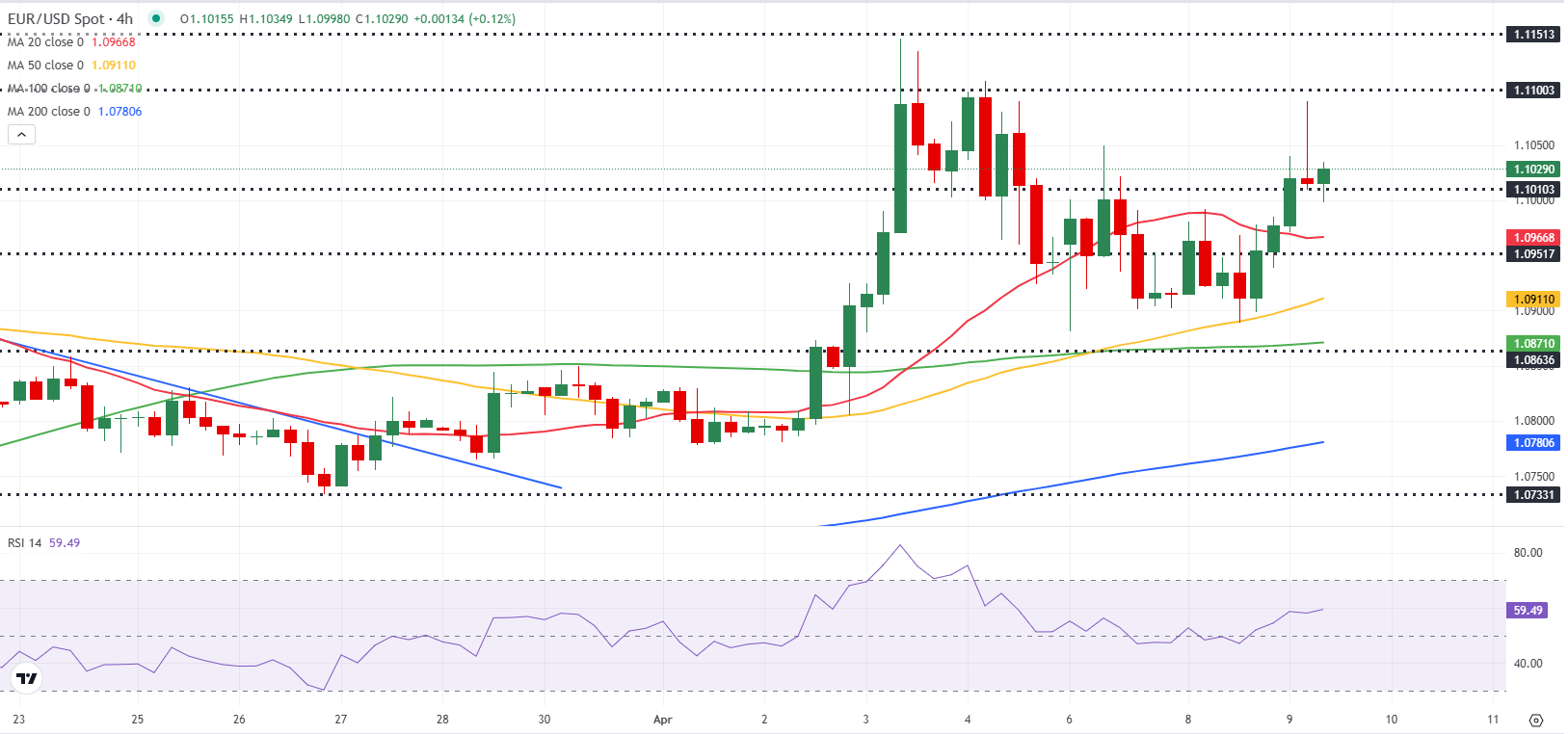- EUR/USD trades in positive territory above 1.1000 on Wednesday.
- The Fed will release the minutes of the March policy meeting later in the day.
- The near-term technical outlook points to a slightly bullish bias.
EUR/USD benefited from the broad-based selling pressure surrounding the US Dollar (USD) during the Asian trading hours and came within a touching distance of 1.1100. The risk-averse market environment, however, seems to be making it difficult for the pair to preserve its bullish momentum. At the time of press, EUR/USD was trading below 1.1050.
Euro PRICE This week
The table below shows the percentage change of Euro (EUR) against listed major currencies this week. Euro was the strongest against the New Zealand Dollar.
| USD | EUR | GBP | JPY | CAD | AUD | NZD | CHF | |
|---|---|---|---|---|---|---|---|---|
| USD | -0.63% | 0.46% | -0.20% | -0.43% | 0.47% | 0.30% | -1.47% | |
| EUR | 0.63% | 1.39% | 1.09% | 0.84% | 1.04% | 1.57% | -0.23% | |
| GBP | -0.46% | -1.39% | -1.58% | -0.55% | -0.34% | 0.17% | -1.60% | |
| JPY | 0.20% | -1.09% | 1.58% | -0.20% | 1.64% | 1.75% | -0.93% | |
| CAD | 0.43% | -0.84% | 0.55% | 0.20% | 0.56% | 0.73% | -1.32% | |
| AUD | -0.47% | -1.04% | 0.34% | -1.64% | -0.56% | 0.52% | -1.27% | |
| NZD | -0.30% | -1.57% | -0.17% | -1.75% | -0.73% | -0.52% | -1.77% | |
| CHF | 1.47% | 0.23% | 1.60% | 0.93% | 1.32% | 1.27% | 1.77% |
The heat map shows percentage changes of major currencies against each other. The base currency is picked from the left column, while the quote currency is picked from the top row. For example, if you pick the Euro from the left column and move along the horizontal line to the US Dollar, the percentage change displayed in the box will represent EUR (base)/USD (quote).
The USD came under selling pressure on Tuesday, with investors growing increasingly concerned over a deepening trade conflict causing the US economy to tip into a recession.
After US President Donald Trump's additional tariffs on China went into effect, several news outlets reported that senior officials from China’s State Council, several government and regulatory bodies will hold a meeting to discuss how to respond to Trump’s tariffs.
Meanwhile, according to Reuters, citing sources with a direct knowledge of the matter, the European Central Bank (ECB) expects the Eurozone growth to take a bigger hit from Trump tariffs than initially estimated. "All agreed that the 0.5 percentage points estimate is too low now and one of them said the impact could be in excess of 1 percentage points," Reuters wrote.
Following this headline, investors could refrain from betting on a persistent Euro strength in the short term.
Later in the American session, the Federal Reserve (Fed) will publish the minutes of the March policy meeting. Since that meeting took place before the tariff announcements, the publication could be ignored by market participants.
EUR/USD Technical Analysis

The Relative Strength Index (RSI) indicator on the 4-hour chart holds above 50 but moves sideways, suggesting that the bullish bias remains intact but lacks momentum.
Looking north, resistances could be located at 1.1050 (static level), 1.1100 (static level) and 1.1145 (April 3 high). On the downside, 1.1000 (static level, round level) aligns as immediate support before 1.0950 (static level) and 1.0900 (static level, round level).
Euro FAQs
The Euro is the currency for the 19 European Union countries that belong to the Eurozone. It is the second most heavily traded currency in the world behind the US Dollar. In 2022, it accounted for 31% of all foreign exchange transactions, with an average daily turnover of over $2.2 trillion a day. EUR/USD is the most heavily traded currency pair in the world, accounting for an estimated 30% off all transactions, followed by EUR/JPY (4%), EUR/GBP (3%) and EUR/AUD (2%).
The European Central Bank (ECB) in Frankfurt, Germany, is the reserve bank for the Eurozone. The ECB sets interest rates and manages monetary policy. The ECB’s primary mandate is to maintain price stability, which means either controlling inflation or stimulating growth. Its primary tool is the raising or lowering of interest rates. Relatively high interest rates – or the expectation of higher rates – will usually benefit the Euro and vice versa. The ECB Governing Council makes monetary policy decisions at meetings held eight times a year. Decisions are made by heads of the Eurozone national banks and six permanent members, including the President of the ECB, Christine Lagarde.
Eurozone inflation data, measured by the Harmonized Index of Consumer Prices (HICP), is an important econometric for the Euro. If inflation rises more than expected, especially if above the ECB’s 2% target, it obliges the ECB to raise interest rates to bring it back under control. Relatively high interest rates compared to its counterparts will usually benefit the Euro, as it makes the region more attractive as a place for global investors to park their money.
Data releases gauge the health of the economy and can impact on the Euro. Indicators such as GDP, Manufacturing and Services PMIs, employment, and consumer sentiment surveys can all influence the direction of the single currency. A strong economy is good for the Euro. Not only does it attract more foreign investment but it may encourage the ECB to put up interest rates, which will directly strengthen the Euro. Otherwise, if economic data is weak, the Euro is likely to fall. Economic data for the four largest economies in the euro area (Germany, France, Italy and Spain) are especially significant, as they account for 75% of the Eurozone’s economy.
Another significant data release for the Euro is the Trade Balance. This indicator measures the difference between what a country earns from its exports and what it spends on imports over a given period. If a country produces highly sought after exports then its currency will gain in value purely from the extra demand created from foreign buyers seeking to purchase these goods. Therefore, a positive net Trade Balance strengthens a currency and vice versa for a negative balance.
Information on these pages contains forward-looking statements that involve risks and uncertainties. Markets and instruments profiled on this page are for informational purposes only and should not in any way come across as a recommendation to buy or sell in these assets. You should do your own thorough research before making any investment decisions. FXStreet does not in any way guarantee that this information is free from mistakes, errors, or material misstatements. It also does not guarantee that this information is of a timely nature. Investing in Open Markets involves a great deal of risk, including the loss of all or a portion of your investment, as well as emotional distress. All risks, losses and costs associated with investing, including total loss of principal, are your responsibility. The views and opinions expressed in this article are those of the authors and do not necessarily reflect the official policy or position of FXStreet nor its advertisers. The author will not be held responsible for information that is found at the end of links posted on this page.
If not otherwise explicitly mentioned in the body of the article, at the time of writing, the author has no position in any stock mentioned in this article and no business relationship with any company mentioned. The author has not received compensation for writing this article, other than from FXStreet.
FXStreet and the author do not provide personalized recommendations. The author makes no representations as to the accuracy, completeness, or suitability of this information. FXStreet and the author will not be liable for any errors, omissions or any losses, injuries or damages arising from this information and its display or use. Errors and omissions excepted.
The author and FXStreet are not registered investment advisors and nothing in this article is intended to be investment advice.
Recommended Content
Editors’ Picks

EUR/USD trims some gains, recedes to 1.1350
Despite losing some upside momentium, EUR/USD keeps the firm tone around the mid-1.1300s on Thursday, buoyed by renewed US Dollar weakness as investors grappled with the continued stalemate in US–China trade negotiations.

GBP/USD puts the 1.3300 level to the test
GBP/USD hovers around the 1.3300 area on Thursday, supported by a broad rebound in risk-sensitive assets, renewed weakness in the Greenback and lingering uncertainty over US–China trade talks.

Gold sticks to the bullish stance near $3,330
On Thursday, gold regained lost ground after two consecutive days of declines, with XAU/USD climbing back toward $3,300 per troy ounce following an earlier rally to roughly $3,370. The metal drew safe-haven buying as renewed fears of a US–China trade flare-up weighed on broader markets.

Bitcoin Price corrects as increased profit-taking offsets positive market sentiment
Bitcoin (BTC) is facing a slight correction, trading around $92,000 at the time of writing on Thursday after rallying 8.55% so far this week. Institutional demand remained strong as US spot Exchange Traded Funds (ETFs) recorded an inflow of $916.91 million on Wednesday.

Five fundamentals for the week: Traders confront the trade war, important surveys, key Fed speech Premium
Will the US strike a trade deal with Japan? That would be positive progress. However, recent developments are not that positive, and there's only one certainty: headlines will dominate markets. Fresh US economic data is also of interest.

The Best brokers to trade EUR/USD
SPONSORED Discover the top brokers for trading EUR/USD in 2025. Our list features brokers with competitive spreads, fast execution, and powerful platforms. Whether you're a beginner or an expert, find the right partner to navigate the dynamic Forex market.